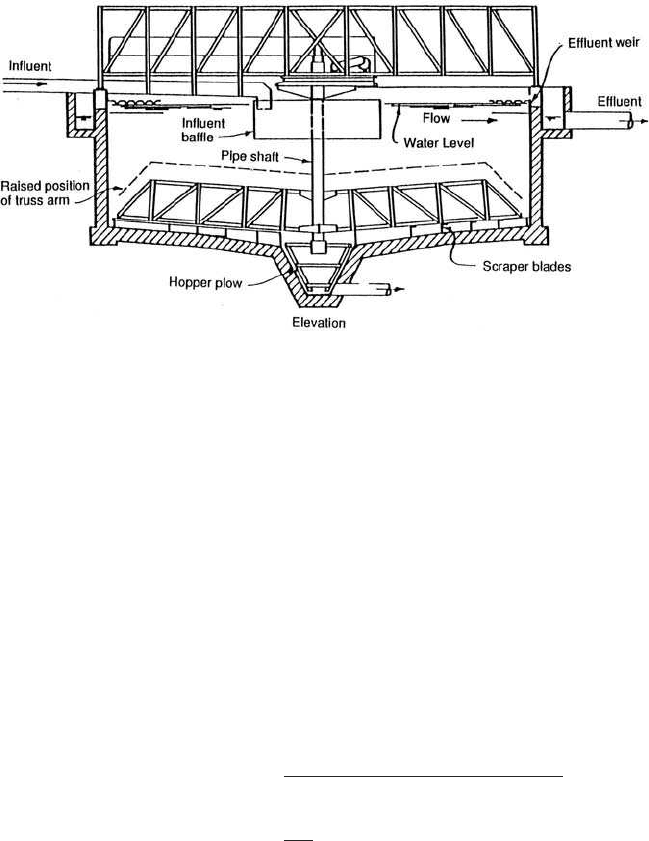Lin S.D. Water and Wastewater Calculations Manual
Подождите немного. Документ загружается.


solution:
Step 1. Determine surface area for denitrification shafts
(a) As in the previous RBC example for BOD removal and nitrification, the
overall hydraulic loading HL
o
⫽ 1.29 gal/(d
.
ft
2
)
The surface area required ⫽ 3,100,000 ft
2
(b) Influent NO
3
-N of denitrification
⫽ (influent ⫺ effluent) NH
3
-N
⫽ (18 ⫺ 2) mg/L
⫽ 16 mg/L
Note: Assume that all NH
3
-N removed is stoichiometrically converted to
NO
3
-N, even though field practice often shows a loss of NO
3
-N.
(c) Referring to Fig. 6.53, the hydraulic loading rate to reduce NO
3
-N from
16 mg/L to 1 mg/L
HL ⫽ 7.45 gal/(d ⭈ ft
2
)
Wastewater Engineering 795
Figure 6.53 Design curves for RBC denitrification of domestic wastewater.

(d) Calculate the surface area for denitrification
Step 2. Select configuration
(a) Use standard media (100,000 ft
2
) for denitrification
(b) Number of shafts
(c) A two-stage operation with three trains is recommended. Install two
assemblies in a separate basin with baffles between adjacent shafts.
29 Sludge (Residuals) Treatment
and Management
Residuals is a term currently used to refer to “sludge.” The bulk of resid-
uals (sludge) generated from wastewater by physical primary and bio-
logical (secondary) and advanced (tertiary) treatment processes must be
treated and properly disposed of. The higher the degree of wastewater
treatment, the larger the quantity of sludge to be treated and handled.
With the advent of strict rules and regulations involving the handling
and disposal of sludge, the need for reducing the volume of sludge has
become increasingly important in order to reduce the operating costs
(approximately 50% of the plant costs) of wastewater treatment plants.
Sludge treatment and disposal is a complex problem facing wastewater
treatment professionals. A properly designed and efficiently operated
sludge processing and disposal system is essential to the overall success
of the wastewater treatment effort.
29.1 Quantity and characteristics of sludge
The quantity and characteristics of the sludge produced depend on the
character of raw wastewater and the wastewater treatment processes.
In the United States, approximately 12,750 public owned treatment
works (POTW) generate 5.4 million dry metric tons of sludge annually,
or 21 kg (47 lb) of dry sewage sludge (biosolids) per person (Federal
Register, 1993).
5 5.4 suse 6 shaftsd
5
540,000 ft
2
100,000 ft
2
5 540,000 ft
2
Surface area 5
4,000,000 gal/d
7.45 gal/sd
#
ft
2
d
796 Chapter 6

Some estimates of the amounts of solids generated by the treatment
unit processes may be inferred from previous examples. Grit collected
from the preliminary treatment units is not biodegradable. It is usually
transported to a sanitary landfill without further treatment.
Characteristics of wastewater sludges, including total solids and volatile
solids contents, pH, nutrients, organic matter, pathogens, metals, organic
chemicals, and hazardous pollutants, are discussed in detail elsewhere
(Federal Register, 1993; US EPA, 1995).
Sludge from primary settling tanks contains from 3% to 7% solids
which are approximately 60% to 80% organic (Davis and Cornwell,
1991; Federal Register, 1993). Primary sludge solids are usually gray
in color, slimy, fairly coarse, and with highly obnoxious odors. Primary
sludge is readily digested under suitable operational conditions (organ-
ics are decomposed by bacteria). Table 6.24 provides the solids concen-
trations of primary sludge and sludge produced in different biological
treatment systems.
Sludge from secondary settling tanks has commonly a brownish, floc-
culant appearance and an earthy odor. If the color is dark, the sludge
may be approaching a septic condition. Secondary sludge consists mainly
of microorganisms (75% to 90% organic) and inert materials. The organic
matter may be assumed to have a specific gravity of 1.01 to 1.06, depend-
ing on its source, whereas the inorganic particles have a specific grav-
ity of 2.5 (McGhee, 1991).
In general, secondary sludges are more flocculant than primary
sludge solids, less fibrous. Waste activated sludge usually contains
0.5% to 2% solids, whereas trickling filter sludge has 2% to 5% solids
(Davis and Cornwell, 1991; Hammer, 1986). Activated sludge and trick-
ling filter sludge can be digested readily, either alone or when mixed
with primary sludge.
Wastewater Engineering 797
TABLE 6.24 Solids Concentrations and Other Characteristics of Various Types of
Sludge
Advanced (tertiary),
Primary, Secondary, chemical precipitation,
Wastewater treatment gravity biological filtration
Sludge
Amounts generated, L/m
3
2.5–3.5 15–20 25–30
of wastewater
Solids content, % 3–7 0.5–2 0.2–1.5
Organic content, % 60–80 50–60 35–50
Treatability, relative easy difficult difficult
Dewatered by belt filter
Feed solids, % 3–7 3–6
Cake solids, % 28–44 20–35
SOURCES: WPCF (1988a), WEF and ASCE (1991b), US EPA (1991)
Sludge from chemical (metal salts) precipitation is generally dark in
color or red (with iron) and slimy. Lime sludge is grayish brown.
Chemical sludge may create odor. Decomposition of chemical sludge
occurs at a slower rate.
The nature of sludge from the tertiary (advanced) treatment process
depends on the unit process. Chemical sludge from phosphorus removal
is difficult to handle and treat. Tertiary sludge combined with biologi-
cal nitrification and denitrification is similar to waste activated sludge.
Example: Estimate the solids generated in the primary and secondary clar-
ifiers at a secondary (activated sludge) treatment plant. Assume that the pri-
mary settling tank removes 65% of the TSS and 33% of the BOD
5
. Also
determine the volume of each sludge, assuming 6% and 1.2% of solids in the
primary and secondary effluents, respectively.
Average plant flow ⫽ 3785 m
3
/d (1 Mgal/d)
Primary influent TSS ⫽ 240 mg/L
Primary influent BOD ⫽ 200 mg/L
Secondary effluent BOD ⫽ 30 mg/L
Secondary effluent TSS ⫽ 24 mg/L
Bacteria growth rate Y ⫽ 0.23 kg (0.5 lb) sludge solids per kg (lb) BOD removed
solution:
Step 1. Calculate the quantity of dry primary solids produced daily
1 mg/L ⫽ 1 g/m
3
Primary sludge ⫽ 3785 m
3
/d ⫻ 240 g/m
3
⫻ 0.65/(1000 g/kg)
⫽ 590 kg/d
⫽ 1300 lb/d
Step 2. Calculate the primary effluent TSS and BOD concentrations
TSS ⫽ 240 mg/L ⫻ (1 ⫺ 0.65) ⫽ 84 mg/L
BOD ⫽ 200 mg/L ⫻ (1 ⫺ 0.33) ⫽ 134 mg/L
Step 3. Calculate TSS removed in the secondary clarifier
Secondary (TSS) solids ⫽ 3785 m
3
/d ⫻ (84 ⫺ 24) (g/m
3
/(1000 g/kg)
⫽ 227 kg/d
⫽ 500 lb/d
Step 4. Calculate biological solids produced due to BOD removal
BOD removed ⫽ 3785 m
3
/d (134 ⫺ 30) g/m
3
/(1000 g/kg)
⫽ 394 kg/d
⫽ 869 lb/d
798 Chapter 6

Biological solids ⫽ 394 kg/d ⫻ Y ⫽ 394 kg/d ⫻ 0.23 kg/kg
⫽ 90 kg/d
⫽ 198 lb/d
Step 5. Calculate total amount of solids produced from the secondary clar-
ifier and from the whole plant (from Steps 3 and 4)
Secondary solids ⫽ (227 ⫹ 90) kg/d
⫽ 317 kg/d
⫽ 698 lb/d
Solids of the plant ⫽ Step 1 ⫹ Step 5
⫽ (590 ⫹ 317) kg/d
⫽ 907 kg/d
⫽ 1998 lb/d
Step 6. Determine the volume of each type of sludge
Assuming sp. gr. of sludge ⫽ 1.0
Mass–volume relation.
The mass of solids in a slurry is related to volatile
and fixed suspended solids contents. The specific gravity (sp. gr.) of a
slurry is
(6.207)
where S
s
⫽ specific gravity of slurry, g/cm
3
or lb/ft
3
m
w
⫽ mass of water, kg or lb
m
v
⫽ mass of VSS, kg or lb
m
f
⫽ mass of FSS, kg or lb
V
s
⫽ volume of sludge slurry, m
3
or ft
3
S
s
5
m
w
1 m
v
1 m
f
V
s
5 6980 gal/d
5 26.4 m
3
/d
Secondary sludge volume V
2
5
317 kg/d
0.012 3 1000 kg/m
3
5 2590 gal/d
5 9.8 m
3
/d
Primary sludge volume V
1
5
590 kg/d
0.06 3 1000 kg/m
3
Wastewater Engineering 799

Since
V
s
⫽ V
w
⫹ V
v
⫹ V
f
(6.208)
where
V
w
, V
v
, V
f
⫽ volume of water, VSS, FSS, m
3
or ft
3
then
(6.209)
where
m
s
⫽ mass of slurry, kg or lb
Moisture content. The moisture (water) r
w
or total solids r
s
content of
a sludge, expressed on a percentage basis, can be computed as
(6.210)
(6.211)
The volume of a sludge, related to its total solids content, is
(6.212)
The specific gravity of organic matter (VSS) is close to that of water
(1.00). The sp. gr. of activated sludge is 1.01 to 1.10, the sp. gr. of FSS
is 2.5, and that for chemical sludge ranges from 1.5 to 2.5 (Droste, 1997).
Example: Determine the sp. gr. of waste activated sludge that contains 80%
VSS and has a solids concentration of 1.5%. Also, determine the volume of
1 kg of sludge.
solution:
Step 1. Calculate mass of VSS, FSS, and water in 1000 g of sludge
1.5% sludge ⫽ 15,000 mg/L of solids
⫽ 15 g/L
VSS ⫽ 15 g/L ⫻ 0.8 ⫽ 12 g/L ⫽m
v
FSS ⫽ 15 g/L ⫻ 0.2 ⫽ 3 g/L ⫽ m
f
If m
s
⫽ 1000 g
Then m
w
⫽ (1000 ⫺ 12 ⫺ 3) g ⫽ 985 g
V
s
5
m
s
sr
s
/100dS
s
p
s
5 100 2 r
w
r
w
5
100m
w
m
w
1 m
s
5
100m
w
m
w
1 m
v
1 m
f
m
s
S
s
5
m
w
S
w
1
m
v
S
v
1
m
f
S
f
800 Chapter 6

Step 2. Calculate sp. gr. of the sludge, using Eq. (6.209)
Step 3. Calculate the volume per kg of sludge
m
s
⫽ 1000 g ⫻ 0.015 ⫽ 15 g
Using Eq. (6.212)
29.2 Sludge treatment alternatives
A variety of treatment processes and overall sludge management options
can be established, depending on the type and quantity of sludge gener-
ated. Figure 6.54 illustrates schematically the wastewater sludge treat-
ment alternatives. The basic processes for sludge treatment include
thickening, stabilization, conditioning, dewatering, and volume reduction.
More details of sludge treatments are available from manufacturers’
manuals and elsewhere (US EPA,1979; 1991; Metcalf and Eddy, Inc. 1991;
WEF and ASCE, 1991b, 1996b).
5 0.998 L
5
15 g
s1.5/100ds1.0018 g/cm
3
ds1000 cm
3
/Ld
V
s
5
m
s
sr
s
/100dS
s
5
15 g
s1.5/100dS
s
S
s
5
1
0.9982
5 1.0018 sg/cm
3
d
1000
S
s
5
985
1.0
1
12
1.0
1
3
2.5
m
s
S
s
5
m
w
S
w
1
m
v
S
v
1
m
f
S
f
Wastewater Engineering 801
Figure 6.54 Sludge processing alternatives.

Sludge thickening. As stated previously, all types of sludge contain a large
volume of water (Table 6.24). The purposes of sludge thickening are to
reduce the sludge volume to be handled in the subsequent sludge pro-
cessing units (pump, digester, dewatering equipment) and to reduce the
construction and operating costs of subsequent processes. Sludge thick-
ening is a procedure used to remove water and increase the solids content.
For example, if waste activated sludge with 0.6% solids is thickened to a
content of 3.0% solids, a five-fold decrease in sludge volume is achieved.
Thickening a sludge with 3% to 8% solids may reduce its volume by
50%. Sludge thickening mainly involves physical processes such as grav-
ity settling, flotation, centrifugation, and gravity belts.
Example: Estimate the sludge volume reduction when the sludge is thick-
ened from 4% to 7% solids concentration. The daily sludge production is
100 m
3
(26,420 gal).
solution:
Step 1. Calculate amount of dry sludge produced
Dry solids ⫽ 100 m
3
.
d ⫻ 1000 kg/m
3
⫻ 0.04
⫽ 4000 kg/d
Step 2. Calculate volume in 7% solids content
Volume ⫽ (4000 kg/d)/[0.07(1000 kg/m
3
)]
⫽ 57.1 m
3
/d
⫽ 15,100 gal/d
Note: Steps 1 and 2 can be solved by the mass balance method:
Volume ⫽ 100 m
3
/d ⫻ 4%/7%
⫽ 57.1 m
3
/d
Step 3. Calculate percentage sludge volume reduction
Gravity thickening. Gravity thickening (Fig. 6.55) uses gravity forces to
separate solids from the sludge. The equipment is similar in design to a
conventional sedimentation basin. Sludge withdrawn from primary clar-
ifiers or sludge blending tanks is applied to the gravity thickener through
a central inlet wall. The normal solids loading rates range from 30 to
60 kg solids per m
2
of tank bottom per day (6 to 12 lb/(ft
2
.
d)) (Hammer,
1986). Coagulant is sometimes added for improving the settling.
5 42.9%
Percent volume reduction 5
s100 2 57.1dm
3
3 100%
100 m
3
802 Chapter 6

Typical hydraulic loading rates are from 16 to 32 m
3
/(m
2
.
d) (390
to 785 gal/(d
.
ft
2
)). For waste activated sludge or for a very thin mix-
ture, hydraulic loading rates range from 4 to 8 m
3
/(m
2
.
d) (100 to 200
gal/ (d
.
ft
2
)) for secondary sludges, and 16 to 32 m
3
/(m
2
.
d) (390 to 785
gal/(d
.
ft
2
)) for primary sludges (US EPA, 1979). For activated sludge,
residence time in the thickener needs to be more than 18 h to reduce
gas production and other undesirable effects (WEF and ASCE, 1991b).
A typical design is a circular tank with a side depth of 3 to 4 m and a
floor sloping at 1:4 to 1:6.
Example 1: A residual with 4% solids is thickened to a 9% solids content.
What is the concentration factor?
solution:
Note: Concentration factor should be 2 or more for primary sludges, and 3 or
more for secondary sludges.
Example 2: A 9 m (30 ft) diameter by 3 m (10 ft) side wall depth gravity
thickener is concentrating a primary sludge. The sludge flow is 303 L/min
(80 gal/min) with average solids content of 4.4%. The thickened sludge is
5 2.25
5
9%
4%
Concentration factor 5
thickened solids concentraiton, %
solids content in influent, %
Wastewater Engineering 803
Figure 6.55 Schematic of gravity thickener (source: US EPA, 1991).
withdrawn at 125 L/min (33 gal/min) with 6.8% solids. The sludge blanket
is 1 m (3.3 ft) thick. The effluent of the thickener has a TSS level of 660 mg/L.
Determine: (1) the sludge detention time; (2) whether the blanket will
increase or decrease in depth under the stated conditions.
solution:
Step 1. Determine the sludge detention time
(a) Compute the volume of the sludge blanket
Volume ⫽ p (9 m/2)
2
⫻ 1 m
⫽ 63.6 m
3
⫽ 63,600 L
(b) Compute the daily sludge pumped
Pumpage ⫽ 125 L/min ⫻ 1440 min/d
⫽ 180,000 L/d
(c) Compute the sludge detention time (DT)
DT ⫽ sludge volume/sludge pumpage
⫽ 63,600 L/(180,000 L/d)
⫽ 0.353 day
⫽ 8.48 h
Step 2. Determine sludge blanket increase or otherwise
(a) Estimate the amount of solids entering the thickener
Assume the sludge ⫽ 1 kg/L
Solids in ⫽ 303 L/min ⫻ 1440 min/d ⫻ 1 kg/L ⫻ 0.044
⫽ 19,200 kg/d
(b) Compute the sludge withdrawal rate
Withdrawal rate ⫽ 125 L/min ⫻ 1440 min/d ⫻ 1 kg/L ⫻ 0.068
⫽ 12,240 kg/d
(c) Compute solids discharge in the effluent of the thickener
Effluent TSS ⫽ 660 mg/L ⫽ 0.066%
Solids lost ⫽ 303 ⫻ 1440 ⫻ 1 ⫻ (0.066%/100%)
⫽ 288 kg/d
say ⫽ 290 kg/d
804 Chapter 6
